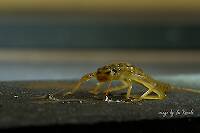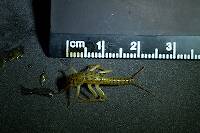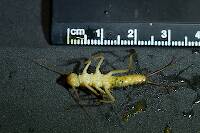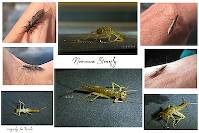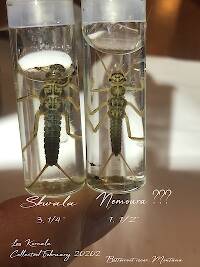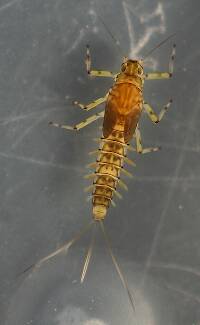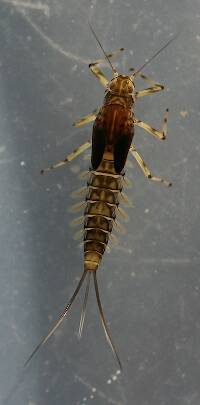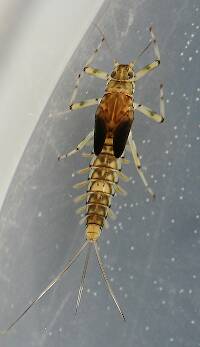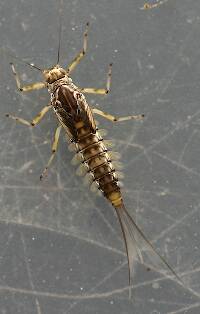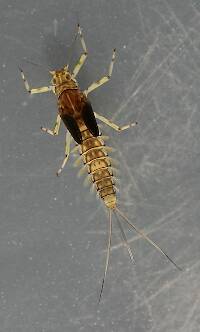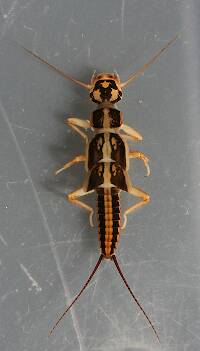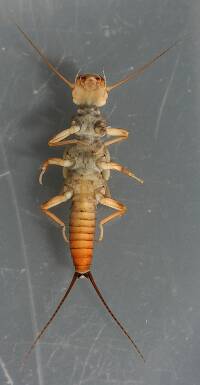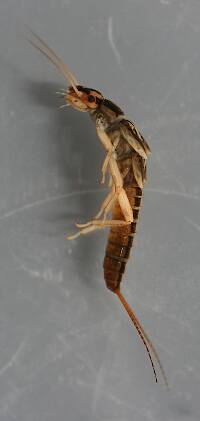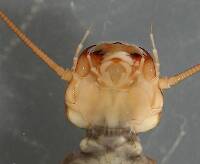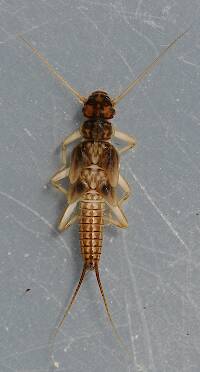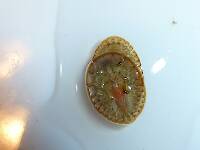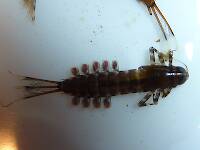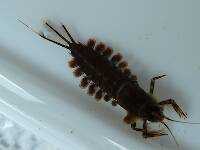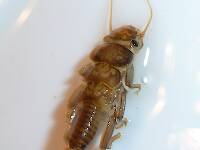
Blue-winged Olives
Baetis
Tiny Baetis mayflies are perhaps the most commonly encountered and imitated by anglers on all American trout streams due to their great abundance, widespread distribution, and trout-friendly emergence habits.
Featured on the forum

This species was fairly abundant in a February sample of the upper Yakima.

Troutnut is a project started in 2003 by salmonid ecologist Jason "Troutnut" Neuswanger to help anglers and
fly tyers unabashedly embrace the entomological side of the sport. Learn more about Troutnut or
support the project for an enhanced experience here.
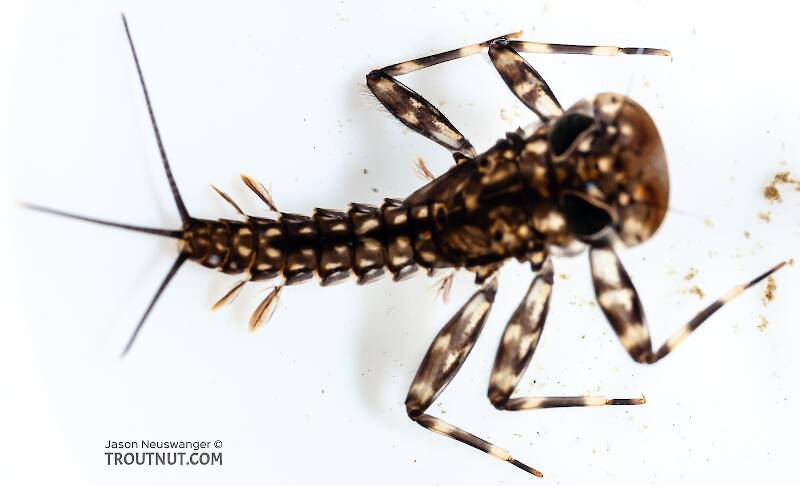
Like most Alaskan mayflies, this one is tricky to identify to the species level. See the discussion section for an informative chat about this one's ID. The current leaning is to call it a fairly immature Heptagenia pulla nymph, but a case has been made for Heptagenia elegantula as well.
Entoman on Jul 13, 2011July 13th, 2011, 10:00 pm EDT
Hi Jason,
Looks like an immature Heptagenia elegantula to me.
regards,
Kurt
Looks like an immature Heptagenia elegantula to me.
regards,
Kurt
"It's not that I find fishing so important, it's just that I find all other endeavors of Man equally unimportant... And not nearly as much fun!" Robert Traver, Anatomy of a Fisherman
Troutnut on Jul 13, 2011July 13th, 2011, 11:59 pm EDT
Do you have any references for these species?
I just looked around online and according to Randolph & McCafferty's Mayflies of Alaska, Heptagenia pulla is the only species in that genus that's been recorded here. But that by no means precludes other species, considering how sparse Alaskan records are.
I just looked around online and according to Randolph & McCafferty's Mayflies of Alaska, Heptagenia pulla is the only species in that genus that's been recorded here. But that by no means precludes other species, considering how sparse Alaskan records are.
Jason Neuswanger, Ph.D.
Troutnut and salmonid ecologist
Troutnut and salmonid ecologist
GONZO on Jul 14, 2011July 14th, 2011, 7:12 am EDT
Jason and Kurt,
Of the Heptagenia species that are known to have a northwestern range, I think it is possible to rule out adaequata, flavescens, and whitingi with some confidence. That leaves elegantula, pulla, and solitaria. The white markings usually tend to coalesce medially on at least the 8th tergite of pulla, and Burks (1953)mentions that that the 1st tergite is almost wholly white. The head also has a narrow white streak extending laterally from the eyes to the lateral margin of the head (as opposed to the broader funnel-shaped white markings found in some other species), but I think it is a matter of interpretation as to whether or not this specimen qualifies in that regard.
It is possible to assemble keys by combining those found in Bednarik and Edmunds (1980) with the emendations in Webb, McCafferty, and Lehmkuhl (2004). Unfortunately, the emended key still uses the length of the tails as a character for separating elegantula and solitaria. Like Kurt, I tend to lean toward elegantula, but IDing Heptagenia nymphs is not easy, and the range of variation found in elegantula nymphs since its synonymization with diabasia makes it difficult to be sure.
If you want to do some tedious work examining the mouthparts with a microscope, you might be able to use the info in the descriptions of Bednarik and Edmunds for confirmation (number of spinelike setae on the crown of the galea-laciniae and the presence or absence of a submedial row of maxillary hair setae on the surface.)
Of the Heptagenia species that are known to have a northwestern range, I think it is possible to rule out adaequata, flavescens, and whitingi with some confidence. That leaves elegantula, pulla, and solitaria. The white markings usually tend to coalesce medially on at least the 8th tergite of pulla, and Burks (1953)mentions that that the 1st tergite is almost wholly white. The head also has a narrow white streak extending laterally from the eyes to the lateral margin of the head (as opposed to the broader funnel-shaped white markings found in some other species), but I think it is a matter of interpretation as to whether or not this specimen qualifies in that regard.
It is possible to assemble keys by combining those found in Bednarik and Edmunds (1980) with the emendations in Webb, McCafferty, and Lehmkuhl (2004). Unfortunately, the emended key still uses the length of the tails as a character for separating elegantula and solitaria. Like Kurt, I tend to lean toward elegantula, but IDing Heptagenia nymphs is not easy, and the range of variation found in elegantula nymphs since its synonymization with diabasia makes it difficult to be sure.
If you want to do some tedious work examining the mouthparts with a microscope, you might be able to use the info in the descriptions of Bednarik and Edmunds for confirmation (number of spinelike setae on the crown of the galea-laciniae and the presence or absence of a submedial row of maxillary hair setae on the surface.)
Entoman on Jul 14, 2011July 14th, 2011, 9:45 am EDT
Jason and Lloyd,
I agree that knowing with absolute certainty will take some microscope work and access to papers mentioned by Lloyd as well as others that may exist. I guess it also remains possible that it could be something unreported. We are talking about Alaska. I remember the day when knowledgable anglers (that should have known better) thought that the Ephemeroptera where virtually unrepresented!
The popular angler entomologies are either silent when it comes to descriptions of most Heptagenia species or have collectively (save Schweibert) accepted the mantra that H. elegantula is a unicolorous shade of brown. In all my wanderings, the only heptaginiids I've ever found that could be described in this way are some Rhithrogena species or perhaps some Cinygmula species. Heptagenia species have always displayed lots of patterning albeit muted in some specimens. With the exception of differentiating between Nixe and Ecdyonurus, I have not found the use of marking pattern comparison very helpful as there seems to be a lot of variation.
Judging the developmental stages of immatures is tricky business, especially when emergence dates are unreported for the region of collection. I suspect that lower 48 tables are of dubious value when dealing with Alaska. With that caveat in mind, I thought of H. pulla but dismissed it primarily over size. I believe H. pulla is a much larger critter that can finish out as large as 14mm while elegantula is typically in the 8mm range. There is also the (admittedly less dependable) lack of a pale 1st tergite and the very large rectangular spot on the 8th indicative of pulla. H. solitaria is described as having a pattern of paired large round spots down the center of the abdominal dorsum that illiminates it as a possibilty. (I see that Bob Newell has recently submitted a photo of solitaria that refutes this. Trusting Bob's judgement, this is further evidence of the dubious nature of pattern or marking comparisons.)
This specimens pronotum is clearly thickest at the front which is also helpful in eliminating other species.
That's the best I can come up with guys.:)
BTW Lloyd, what is the rule for using the plural genus name? Is it deer or horses? Or is there a latin "ii" or something? It gets tiresome always adding "species of the ----- genus":)
Best regards,
Kurt
I agree that knowing with absolute certainty will take some microscope work and access to papers mentioned by Lloyd as well as others that may exist. I guess it also remains possible that it could be something unreported. We are talking about Alaska. I remember the day when knowledgable anglers (that should have known better) thought that the Ephemeroptera where virtually unrepresented!
The popular angler entomologies are either silent when it comes to descriptions of most Heptagenia species or have collectively (save Schweibert) accepted the mantra that H. elegantula is a unicolorous shade of brown. In all my wanderings, the only heptaginiids I've ever found that could be described in this way are some Rhithrogena species or perhaps some Cinygmula species. Heptagenia species have always displayed lots of patterning albeit muted in some specimens. With the exception of differentiating between Nixe and Ecdyonurus, I have not found the use of marking pattern comparison very helpful as there seems to be a lot of variation.
Judging the developmental stages of immatures is tricky business, especially when emergence dates are unreported for the region of collection. I suspect that lower 48 tables are of dubious value when dealing with Alaska. With that caveat in mind, I thought of H. pulla but dismissed it primarily over size. I believe H. pulla is a much larger critter that can finish out as large as 14mm while elegantula is typically in the 8mm range. There is also the (admittedly less dependable) lack of a pale 1st tergite and the very large rectangular spot on the 8th indicative of pulla. H. solitaria is described as having a pattern of paired large round spots down the center of the abdominal dorsum that illiminates it as a possibilty. (I see that Bob Newell has recently submitted a photo of solitaria that refutes this. Trusting Bob's judgement, this is further evidence of the dubious nature of pattern or marking comparisons.)
This specimens pronotum is clearly thickest at the front which is also helpful in eliminating other species.
That's the best I can come up with guys.:)
BTW Lloyd, what is the rule for using the plural genus name? Is it deer or horses? Or is there a latin "ii" or something? It gets tiresome always adding "species of the ----- genus":)
Best regards,
Kurt
"It's not that I find fishing so important, it's just that I find all other endeavors of Man equally unimportant... And not nearly as much fun!" Robert Traver, Anatomy of a Fisherman
Troutnut on Jul 14, 2011July 14th, 2011, 1:03 pm EDT
Sounds like we've got a tentative consensus on elegantula, then. I might have time to look for those papers and stare at the mouth parts under a microscope later.
Jason Neuswanger, Ph.D.
Troutnut and salmonid ecologist
Troutnut and salmonid ecologist
Konchu on Jul 14, 2011July 14th, 2011, 1:19 pm EDT
see Webb et al. 2007 for more
Entoman on Jul 14, 2011July 14th, 2011, 1:51 pm EDT
Thanks Luke. Enjoyed reading that immensely. Interesting comments regarding the utility of color and pattern descriptions in determining Heptagenia nymphs.
Kurt
Kurt
"It's not that I find fishing so important, it's just that I find all other endeavors of Man equally unimportant... And not nearly as much fun!" Robert Traver, Anatomy of a Fisherman
GONZO on Jul 14, 2011July 14th, 2011, 5:12 pm EDT
BTW Lloyd, what is the rule for using the plural genus name? Is it deer or horses? Or is there a latin "ii" or something? It gets tiresome always adding "species of the ----- genus":)
It's sorta like "deer," Kurt. The rule is that you don't change the spelling of a capitalized genus name, even if you know all the rules for forming plurals in Latin (and I don't). (Uncapitalized derivative forms follow either English or Latin rules for plural formation.)
So, you just use the genus name. (And you don't add an "s.") As far as subject/verb agreement, I believe it would depend on whether you were referring to the genus as a genus (singular verb) or the species in the genus (plural verb). Sometimes the "species of (insert genus here)" construction, or just "(insert genus) spp.," is clearer. :)
Entoman on Jul 15, 2011July 15th, 2011, 6:47 am EDT
Thanks Lloyd. I'm going to paste it and print it up for desktop use until it sticks in my brain. Now If I can just get my browser to spellcheck like my Mac does at home, I'll be in pretty good shape.:)
BTW - Speaking of sticking in the brain, we've been looking at so many Drunella species lately you typed flavilinea instead of flavescens.:)
Kurt
BTW - Speaking of sticking in the brain, we've been looking at so many Drunella species lately you typed flavilinea instead of flavescens.:)
Kurt
"It's not that I find fishing so important, it's just that I find all other endeavors of Man equally unimportant... And not nearly as much fun!" Robert Traver, Anatomy of a Fisherman
GONZO on Jul 15, 2011July 15th, 2011, 7:28 am EDT
Good catch, Kurt. Thanks. I do seem to be suffering from Drunella fixation. One good turn deserves another: the spelling in the title of this thread should be "heptageniid." :)
Entoman on Jul 15, 2011July 15th, 2011, 7:44 am EDT
Ha! Not according to Mr. Schwiebert in his revision of "Nymphs". You're right about the spelling though, I just couldn't help pointing out the "company" I keep.:) See what I mean about my spellcheck?
"It's not that I find fishing so important, it's just that I find all other endeavors of Man equally unimportant... And not nearly as much fun!" Robert Traver, Anatomy of a Fisherman
GONZO on Jul 15, 2011July 15th, 2011, 8:12 am EDT
Yeah, I know someone who once tried to produce a book that was free from typos and errors, but he failed. ;)
Oldredbarn on Jul 15, 2011July 15th, 2011, 8:46 am EDT
I want to apologise up front here because I'm a bit tired today and not firing on all cylinders, I saw Toots and the Maytals Wednesday evening, it's going to take a moment or two before all is right again with the world...In short, the old-fart can't hang anymore!
I have read where Kurt has bemoaned DNA analysis before in other threads and where this may lead us, down the road very soon, but after reading the following from Luke's link above, after my eyes glassed over, I'm not too sure what this old dedicated "match-the-hatcher" is suppose to do...What do I conclude from all this??? "Spence won't need to tie any separate patterns for a particular fly until the DNA results diverge to such-and-such percentage...If within a specified range the fly you have been using should cover all the above listed bugs." ;) Instead of all those confusing quaint names we have used in the past this group will from here-on-in be known as RN1, RN1a, RN1b and so on and so forth...This should clear it all up buck-o!
"Spence."
"Yes."
"When in doubt, tie on a Borcher's!"
"Ok. I think I get it now." ;)
I have read where Kurt has bemoaned DNA analysis before in other threads and where this may lead us, down the road very soon, but after reading the following from Luke's link above, after my eyes glassed over, I'm not too sure what this old dedicated "match-the-hatcher" is suppose to do...What do I conclude from all this??? "Spence won't need to tie any separate patterns for a particular fly until the DNA results diverge to such-and-such percentage...If within a specified range the fly you have been using should cover all the above listed bugs." ;) Instead of all those confusing quaint names we have used in the past this group will from here-on-in be known as RN1, RN1a, RN1b and so on and so forth...This should clear it all up buck-o!
Data analysis
A matrix of Kimura-2-parameter (K2P) distances was calculated in MEGA3 (Table 1) and used to construct a neighbor-joining tree. Bootstrap analysis with 1000 replicates was performed on the neighbor-joining tree using MEGA3. The K2P model is appropriate when genetic distances are low (Nei and Kumar 2000) and has previously been used in studies of mtDNA barcoding (e.g., Hebert et al. 2003a, b, Ball et al. 2005, Hajibabaei et al. 2006).
Intraspecific sequence divergences based on K2P distance were calculated as the mean of all intraspecific pairwise divergences for a given taxon. Interspecific sequence divergence based on K2P distance was calculated as the mean of all pairwise divergences between two taxa.
To infer species relationships, a maximum parsimony analysis was conducted in PAUP* (v4.0b10, Sinauer Associates, Sunderland, MA). Sequences of two other Heptageniidae, obtained from GenBank were used as outgroups: Epeorus fragilis (Morgan) (GenBank accession AY326821), a member of the Rhithrogeninae, and Stenacron interpunctatum (Say) (GenBank accession AY326942), a member of the Heptageniinae. Bootstrap values were calculated with 1000 replicates.
"Spence."
"Yes."
"When in doubt, tie on a Borcher's!"
"Ok. I think I get it now." ;)
"Even when my best efforts fail it's a satisfying challenge, and that, after all, is the essence of fly fishing." -Chauncy Lively
"Envy not the man who lives beside the river, but the man the river flows through." Joseph T Heywood
"Envy not the man who lives beside the river, but the man the river flows through." Joseph T Heywood
GONZO on Jul 15, 2011July 15th, 2011, 9:14 am EDT
Instead of all those confusing quaint names we have used in the past this group will from here-on-in be known as RN1, RN1a, RN1b and so on and so forth...
Relax, Spence. I'm pretty sure that fly fishers will be calling dozens of species "BWOs" and using the old standby of size and color to match the hatch well into the foreseeable future. Anyway, how old are you? If some future generations want to call a "Light Cahill" a "GenBank accession AY326942," it's not something old guys like us should fret about. Our concern (and obligation) should be to ensure that there are bugs and trout for them to enjoy. Just a thought from a fellow "old-schooler." ;)
Oldredbarn on Jul 15, 2011July 15th, 2011, 9:58 am EDT
Anyway, how old are you?
Old enough to know who Toots and the Maytals are...:) Toots started out in 1963...Ouch! Actually I was surprised at the age groups at the show and the "youngsters" were singing along...I was shocked...I go in to Ann Arbor to see some old-fart entertainer and I swear that the "old folks" I see in the lobby are in no way of my generation...Can't be! Gray hair, walking with canes, bald heads etc...
When we go to these shows, and we see the aging hippie generation, I always tell my wife that I was precocious...Way ahead of the "hipness-curve" as a child...She pats me on my balding head and says, "Yes dear! Anything you say. Did you remember to bring your glasses?" :)
it's not something old guys like us should fret about. Our concern (and obligation) should be to ensure that there are bugs and trout for them to enjoy. Just a thought from a fellow "old-schooler." ;)
Ditto G! I'm just poking another stick at the dialectic.
Spence
"Even when my best efforts fail it's a satisfying challenge, and that, after all, is the essence of fly fishing." -Chauncy Lively
"Envy not the man who lives beside the river, but the man the river flows through." Joseph T Heywood
"Envy not the man who lives beside the river, but the man the river flows through." Joseph T Heywood
Falsifly on Jul 15, 2011July 15th, 2011, 10:44 am EDT
And then comes the second guessing, and the blame game to full circle. Buy another book, a new rod or maybe a line; try that new invisible leader and tippet material, or that new fly I saw on the front page of last months magazine. Oh wait, no that can’t be it, then it dawns on me. I’m remiss in that which is most important; I have committed the sin of all sins. In my zealous attempt to lure Bright Sides to my tackle terminating make-believe Ephemeroptera, I’ve failed to check if that little Pronouncith icantith has been reclassified to some other genus or species due to a recently discovered gene.
Falsifly
When asked what I just caught that monster on I showed him. He put on his magnifiers and said, "I can't believe they can see that."
When asked what I just caught that monster on I showed him. He put on his magnifiers and said, "I can't believe they can see that."
Oldredbarn on Jul 15, 2011July 15th, 2011, 11:00 am EDT
In my zealous attempt to lure Bright Sides to my tackle terminating make-believe Ephemeroptera, I’ve failed to check if that little Pronouncith icantith has been reclassified to some other genus or species due to a recently discovered gene.
Allan,
This is funny!
What will we do when the trout sticks his nose right up under our "plausible fraud" and follows it downstream a bit only to turn away at the last minute while exclaiming, "That's a replica of my cousin arse-hole! I'm Genbank accession AY326942...That fly's AY326945! The boys at Purdue straightened this out three whole years ago blockhead...Where have you been?!"
Spence
I just posted this and decided to pull it right back up...On second thought we won't need to worry Allan because in the near future we will be able to stand in our favorite hole and a little GPS unit in our pocket will automatically update itself, tell us where we are, and the actual species of insecta known to exist there where we stand right down to its genome...Then it will suggest, "When in doubt, tie on a Borcher's"...Ha, ha, ha...I just couldn't resist...Sorry !
This new unit will be able to inform you that your casting stroke is off and there is a tailing loop, the air temp and air speed, and the stress calculation on your terminal knot...The strange bikini clad female just now floating by you on the stream, well her names "such-and-such", she just went through a horrible divorce and her blood pressure just increased a notch when she was checking you out...In a fake computer generated voice, "Put fly rod down,! Put fly rod down! Pursue!, Pursue!"
If you have purchased the right app Joe Humphrey's, Joan Wulff, Ed Jaworski, or good old Lefty Kreh will give you step-by-step on stream instuction to tighten up that loop! "The Future's So Bright We'll Have To Wear Shades!"
"Even when my best efforts fail it's a satisfying challenge, and that, after all, is the essence of fly fishing." -Chauncy Lively
"Envy not the man who lives beside the river, but the man the river flows through." Joseph T Heywood
"Envy not the man who lives beside the river, but the man the river flows through." Joseph T Heywood
Troutnut on Jul 15, 2011July 15th, 2011, 12:30 pm EDT
I'm pretty sure that fly fishers will be calling dozens of species "BWOs" and using the old standby of size and color to match the hatch well into the foreseeable future.
Perhaps we on this forum can begin to push the envelope on what constitutes a "BWO," too. A thousand coolness points await the first person to name a dog Blue-Winged Olive, or "Bewo" for short.
Jason Neuswanger, Ph.D.
Troutnut and salmonid ecologist
Troutnut and salmonid ecologist
Falsifly on Jul 15, 2011July 15th, 2011, 1:08 pm EDT
Here is the lead-in to my above post.
Yeah, I got sucked into “Aquatic Entomology”. How could we possibly be successful, let alone complete, without a comprehensive understanding of the “fly”? Yes, by all means lets wrap it all up in science, and presto fish will be caught! But what about all those years in practice and countless hours studying writ, is that not deception in itself? If not then, why I ask, do I return without the slightest hint of the fishy smell upon my palm? I’ve purchased scores of bound parchment weighed heavy with script and interspersed with tantalizing pictorial depictions guaranteed to whet an appetite, some even signed by the Sage himself, and video presentations on the “How To” subject of fly fishing my meager allowance would permit, devouring it all. After years of compilation, I now stand before a virtual library of science, philosophy, and the melding of the two, as it all pertains to the piquing of the pea brained Pisces’ psyche. I have deprived myself of basic sustenance, locking myself up in the total immersion of study, almost to the point of medical intervention by my loved ones, in hopes of reviving my sanity. I have disappeared for months at a time, on wandering westward trips, in search of esoteric truths through religious like commitments of practice. And yet my standing at the top wrung of evolutions latter, at least in terms of mental capacity, still, leaves me wanting in my ability to pull the wool over the eyes of my finny foe.
Falsifly
When asked what I just caught that monster on I showed him. He put on his magnifiers and said, "I can't believe they can see that."
When asked what I just caught that monster on I showed him. He put on his magnifiers and said, "I can't believe they can see that."
GONZO on Jul 15, 2011July 15th, 2011, 1:21 pm EDT
A thousand coolness points await the first person to name a dog Blue-Winged Olive, or "Bewo" for short.
...and ten thousand points for the first person to name their daughter Blue-Winged Olive. (Heck, I think it's better than Harper Seven.)
Quick Reply
Related Discussions
Topic
Replies
Last Reply
0
Jul 10, 2006
by Troutnut
by Troutnut
2
Feb 24, 2020
by Leskorcala
by Leskorcala







